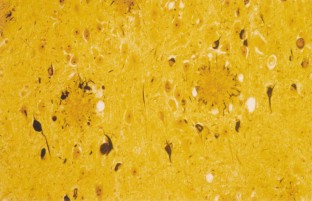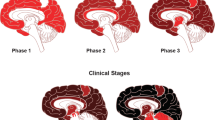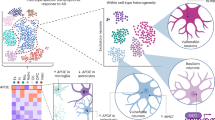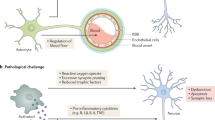Abstract
Studies of the molecular basis of Alzheimer's disease exemplify the increasingly blurred distinction between basic and applied biomedical research.The four genes so far implicated in familial Alzheimer's disease have each been shown to elevate brain levels of the self-aggregating amyloid-β protein, leading gradually to profound neuronal and glial alteration, synaptic loss and dementia. Progress in understanding this cascade has helped to identify specific therapeutic targets and provides a model for elucidating other neurodegenerative disorders.
This is a preview of subscription content, access via your institution
Access options
Subscribe to this journal
Receive 51 print issues and online access
199,00 € per year
only 3,90 € per issue
Buy this article
- Purchase on SpringerLink
- Instant access to full article PDF
Prices may be subject to local taxes which are calculated during checkout




Similar content being viewed by others
References
Dickson, D. W. The pathogenesis of senile plaques. J. Neuropathol. Exp. Neurol. 56, 321–339 (1997).
Yamaguchi, H., Nakazato, Y., Hirai, S., Shoji, M. & Harigaya, Y. Electron micrograph of diffuse plaques: initial stage of senile plaque formation in the Alzheimer brain. Am. J. Pathol. 135, 593–597 (1989).
Goedert, M., Trojanowski, J. Q. & Lee, V. M.-Y. in The Molecular and Genetic Basis of Neurological Disease, 2nd edn (eds Rosenberg, R. N., Prusiner, S. B., DiMauro, S. & Barchi, R. L.) 613–627 (Butterworth-Heinemann, Boston, 1996).
Strittmatter, W. J. et al. Apolipoprotein E: high-avidity binding to β-amyloid and increased frequency of type 4 allele in late-onset familial Alzheimer disease. Proc. Natl Acad. Sci. USA 90, 1977–1981 (1993).
Saunders, A. M. et al. Association of apolipoprotein E allele epsilon 4 with late-onset familial and sporadic Alzheimer's disease. Neurology 43, 1467–1472 (1993).
Sherrington, R. et al. Cloning of a novel gene bearing missense mutations in early onset familial Alzheimer disease. Nature 375, 754–760 (1995).
Levy-Lahad, E. et al. Candidate gene for the chromosome 1 familial Alzheimer's disease locus. Science 269, 973–977 (1995).
Rogaev, E. I. et al. Familial Alzheimer's disease in kindreds with missense mutations in a gene on chromosome 1 related to the Alzheimer's disease type 3 gene. Nature 376, 775–778 (1995).
Blacker, D. et al. Alpha-2 macroglobulin is genetically associated with Alzheimer disease. Nature Genet. 19, 357–360 (1998).
Spillantini, M. G. et al. Mutation in the tau gene in familial multiple system tauopathy with presenile dementia. Proc. Natl Acad. Sci. USA 95, 7737–7741 (1998).
Hutton, M. et al. Association of missense and 5′-splice-site mutations in tau with the inherited FTDP-17. Nature 393, 702–705 (1998).
Poorkaj, P. et al. Tau is a candidate gene for chromosome 17 frontotemporal dementia. Ann. Neurol. 43, 815–825 (1998).
Goedert, M. Tau mutations cause frontotemporal dementias. Neuron 21, 955–958 (1998).
Kang, J. et al. The precursor of Alzheimer's disease amyloid A4 protein resembles a cell-surface receptor. Nature 325, 733–736 (1987).
Glenner, G. G. & Wong, C. W. Alzheimer's disease and Down's syndrome: sharing of a unique cerebrovascular amyloid fibril protein. Biochem. Biophys. Res. Commun. 122, 1131–1135 (1984).
Selkoe, D. J. Cell biology of the amyloid β-protein precursor and the mechanism of Alzheimer's disease. Annu. Rev. Cell Biol. 10, 373–403 (1994).
Zheng, H. et al. β-amyloid precursor protein-deficient mice show reactive gliosis and decreased locomotor activity. Cell 81, 525–531 (1995).
Perez, R. G., Zheng, H., Van der Ploeg, L. H. & Koo, E. H. The beta-amyloid precursor protein of Alzheimer's disease enhances neuron viability and modulates neuronal polarity. J. Neurosci. 17, 9407–9414 (1997).
Wasco, W. et al. Identification of a mouse brain cDNA that encodes a protein related to the Alzheimer disease-associated amyloid β-protein precursor. Proc. Natl Acad. Sci. USA 89, 10758–10762 (1992).
Slunt, H. H. et al. Expression of a ubiquitous, cross-reactive homologue of the mouse β-amyloid precursor protein (APP). J. Biol. Chem. 269, 2637–2644 (1994).
Sisodia, S. S. β-amyloid precursor protein cleavage by a membrane-bound protease. Proc. Natl Acad. Sci. USA 89, 6075–6079 (1992).
Black, R. A. et al. A metalloproteinase disintegrin that releases tumour-necrosis factor-α from cells. Nature 385, 729–733 (1997).
Buxbaum, J. D. et al. Evidence that tumor necrosis factor alpha converting enzyme is involved in regulated alpha-secretase cleavage of the Alzheimer amyloid protein precursor. J. Biol. Chem. 273, 27765–27767 (1998).
Haass, C. et al. Amyloid β-peptide is produced by cultured cells during normal metabolism. Nature 359, 322–325 (1992).
Shoji, M. et al. Production of the Alzheimer amyloid β protein by normal proteolytic processing. Science 258, 126–129 (1992).
Seubert, P. et al. Isolation and quantitation of soluble Alzheimer's β-peptide from biological fluids. Nature 359, 325–327 (1992).
Busciglio, J., Gabuzda, D. H., Matsudaira, P. & Yankner, B. A. Generation of β-amyloid in the secretory pathway in neuronal and nonneuronal cells. Proc. Natl Acad. Sci. USA 90, 2092–2096 (1993).
Seubert, P. et al. Secretion of β-amyloid precursor protein cleaved at the amino-terminus of the β-amyloid peptide. Nature 361, 260–263 (1993).
Levitan, D. & Greenwald, I. Facilitation of lin-12-mediated signalling by sel-12,a Caenorhabditis elegans S182 Alzheimer's disease gene. Nature 377, 351–354 (1995).
Levitan, D. et al. Assessment of normal and mutant human presenilin function in Caenorhabditis elegans . Proc. Natl Acad. Sci. USA 93, 14940–14944 (1996).
Baumeister, R. et al. Human presenilin-1, but not familial Alzheimer's disease (FAD) mutants, facilitate Caenorhabditis elegans notch signalling independently of proteolytic processing. Genes Function 1, 149–159 (1997).
Zhou, J. et al. Presenilin 1 interaction in the brain with a novel member of the Armadillo family. NeuroReport 8, 2085–2090 (1997).
Yu, G. et al. The presenilin 1 protein is a component of a high molecular weight intracellular complex that contains beta-catenin. J. Biol. Chem. 273, 16470–16475 (1998).
Wong, P. et al. Presenilin 1 is required for Notch 1 and D111 expression in the paraxial mesoderm. Nature 397, 288 (1997).
Shen, J. et al. Skeletal and CNS defects in presenilin-1 deficient mice. Cell 89, 629–639 (1997).
Qian, S. et al. Mutant human presenilin 1 protects presenilin 1 null mouse against embryonic lethality and elevates Abeta1-42/43 expression. Neuron 20, 611–617 (1998).
Thinakaran, G. et al. Endoprotreolysis of presenilin 1 and accumulation of processed derivatives in vivo . Neuron 17, 181–190 (1996).
Podlisny, M. B. et al. Presenilin proteins undergo heterogeneous endoproteolysis between Thr291 and Ala299 and occur as stable N- and C-terminal fragments in normal and Alzheimer brain tissue. Neurobiol. Dis. 3, 325–337 (1997).
Li, X. & Greenwald, I. Additional evidence for an eight-transmembrane-domain topology for Caenorhabditis elegans and human presenilins. Proc. Natl Acad. Sci. USA 95, 7109–7114 (1998).
Thinakaran, G. et al. Evidence that levels of presenilins (PS1 and PS2) are coordinately regulated by competition for limiting cellular factors. J. Biol. Chem. 272, 28415–28422 (1997).
Steiner, H. et al. Expression of Alzheimer's disease-associated presenilin-1 is controlled by proteolytic degradation and complex formation. J. Biol. Chem. 273, 32322–32331 (1998).
Capell, A. et al. The proteolytic fragments of the Alzheimer's disease-associated presenilin-1 form heterodimers and occur as a 100-150-kDa molecular mass complex. J. Biol. Chem. 273, 3205–3211 (1998).
Zhang, J. et al. Subcellular distribution and turnover of presenilins in transfected cells. J. Biol. Chem. 273, 12436–12442 (1998).
Scheuner, D. et al. Secreted amyloid β-protein similar to that in the senile plaques of Alzheimer's disease is increased in vivo by the presenilin 1 and 2 and APP mutations linked to familial Alzheimer's disease. Nature Med. 2, 864–870 (1996).
Tomita, T. et al. Molecular dissection of domains in mutant presenilin 2 that mediate overproduction of amyloidogenic forms of amyloid beta peptides. Inability of truncated forms of PS2 with familial Alzheimer's disease mutation to increase secretion of Abeta42. J. Biol. Chem. 273, 21153–21160 (1998).
Selkoe, D. J. Alzheimer's disease: genotypes, phenotype, and treatments. Science 275, 630–631 (1997).
Lemere, C. A. et al. Sequence of deposition of heterogeneous amyloid β-peptides and Apo E in Down syndrome: implications for initial events in amyloid plaque formation. Neurobiol. Dis. 3, 16–32 (1996).
Mann, D. M. et al. Microglial cells and amyloid beta protein (A beta) deposition; association with A beta 40-containing plaques. Acta Neuropathol. (Berl.) 90, 472–477 (1995).
Levy, E. et al. Mutation of the Alzheimer's disease amyloid gene in hereditary cerebral hemorrhage, Dutch-type. Science 248, 1124–1126 (1990).
Hendriks, L. et al. Presenile dementia and cerebral haemorrhage linked to a mutation at codon 692 of the β-amyloid precursor protein gene. Nature Genet. 1, 218–221 (1992).
Biere, A. L. et al. Co-expression of β-amyloid precursor protein (βAPP) and apolipoprotein E in cell culture: analysis of βAPP processing. Neurobiol. Dis. 2, 177–187 (1995).
Schmechel, D. E. et al. Increased amyloid β-peptide deposition in cerebral cortex as a consequence of apolipoprotein E genotype in late-onset Alzheimer disease. Proc. Natl Acad. Sci. USA 90, 9649–9653 (1993).
Rebeck, G. W., Reiter, J. S., Strickland, D. K. & Hyman, B. T. Apolipoprotein E in sporadic Alzheimer's disease: allelic variation and receptor interactions. Neuron 11, 575–580 (1993).
Ma, J., Yee, A., Brewer, H. B. Jr, Das, S. & Potter, H. The amyloid-associated proteins α1-antichymotrypsin and apolipoprotein E promote the assembly of the Alzheimer β-protein into filaments. Nature 372, 92–94 (1994).
Evans, K. C., Berger, E. P., Cho, C.-G., Weisgraber, K. H. & Lansbury, P. T. Jr Apolipoprotein E is a kinetic but not a thermodynamic inhibitor of amyloid formation: implications for the pathogenesis and treatment of Alzheimer disease. Proc. Natl Acad. Sci. USA 92, 763–767 (1995).
Bales, K. R. et al. Lack of apolipoprotein E dramatically reduces amyloid β-peptide deposition. Nature Genet. 17, 263–264 (1997).
Hardy, J. The Alzheimer family of diseases: many etiologies, one pathogenesis? Proc. Natl Acad. Sci. USA 94, 2095–2097 (1997).
Holcomb, L. et al. Accelerated Alzheimer-type phenotype in transgenic mice carrying both mutant amyloid precursor protein and presenilin 1 transgenes. Nature Med. 4, 97–100 (1998).
Lemere, C. A. et al. The E280A presenilin 1 Alzheimer mutation produces increased Aβ42 deposition and severe cerebellar pathology. Nature Med. 2, 1146–1148 (1996).
Mann, D. M. A. et al. Amyloid beta protein (A-beta) deposition in chromosome 14-linked Alzheimer's disease—predominance of A-beta (42(43)). Ann. Neurol. 40, 149–156 (1996).
Thinakaran, G. et al. Stable association of presenilin derivatives and absence of presenilin interactions with APP. Neurobiol. Dis. 4, 438–453 (1998).
Xia, W. et al. Presenilin 1 regulates the processing APP C-terminal fragments and the generation of amyloid β-protein in ER and Golgi. Biochemistry 37, 16465–16471 (1998).
Weidemann, A. et al. Formation of stable complexes between two Alzheimer's disease gene products: presenilin-2 and β-amyloid precursor protein. Nature Med. 3, 328–332 (1997).
Xia, W., Zhang, J., Perez, R., Koo, E. H. & Selkoe, D. J. Interaction between amyloid precursor protein and presenilins in mammalian cells: implications for the pathogenesis of Alzheimer's disease. Proc. Natl Acad. Sci. USA 94, 8208–8213 (1997).
Wolfe, M. S. et al. Two transmembrane aspartates in presenilin-1 required for presenilin endoproteolysis and β-secretase activity. Nature 398, 513–517 (1999).
De Strooper, B. et al. Deficiency of presenilin-1 inhibits the normal cleavage of amyloid precursor protein. Nature 391, 387–390 (1998).
Schroeter, E. H., Kisslinger, J. A. & Kopan, R. Notch-1 signalling requires ligand-induced proteolytic release of intracellular domain. Nature 393, 382–386 (1998).
Brockhaus, M. et al. Caspase-mediated cleavage is not required for the activity of presenilins in amyloidogenesis and NOTCH signaling. NeuroReport 9, 1481–1486 (1998).
Skovronsky, D. M., Doms, R. W. & Lee, V. M.-Y. Detection of a novel intraneuronal pool of insoluble amyloid β protein that accumulates with time in culture. J. Cell Biol. 141, 1031–1039 (1998).
Eikelenboom, P., Zhan, S. S., van Gool, W. A. & Allsop, D. Inflammatory mechanisms in Alzheimer's disease. Trends Pharmacol. Sci. 15, 447–450 (1994).
McGeer, P. L. & McGeer, E. G. The inflammatory response system of brain: implications for therapy of Alzheimer and other neurodegenerative diseases. Brain Res. Rev. 21, 195–218 (1995).
Rogers, J. et al. Inflammation and Alzheimer's disease pathogenesis. Neurobiol. Aging 17, 681–686 (1996).
Rogers, J. et al. Complement activation by β-amyloid in Alzheimer disease. Proc. Natl Acad. Sci. USA 89, 10016–10020 (1992).
Itagaki, S., Akiyama, H., Saito, H. & McGeer, P. L. Ultrastructural localization of complement membrane attack complex (MAC)-like immunoreactivity in brains of patients with Alzheimer's disease. Brain Res. 645, 78–84 (1994).
Behl, C., Davis, J. B., Lesley, R. & Schubert, D. Hydrogen peroxide mediates amyloid β protein toxicity. Cell 77, 817–827 (1994).
Harris, M. E., Hensley, K., Butterfield, D. A., Leedle, R. A. & Carney, J. M. Direct evidence of oxidative injury produced by the Alzheimer's beta-amyloid peptide (1-40) in cultured hippocampal neurons. Exp. Neurol. 131, 193–202 (1995).
Sano, M. et al. A controlled trial of selegiline, alpha-tocopherol, or both as treatment for Alzheimer's disease. The Alzheimer's Disease Cooperative Study. N. Engl. J. Med. 336, 1216–1222 (1997).
Mattson, M. P. et al. β-Amyloid peptides destabilize calcium homeostasis and render human cortical neurons vulnerable to excitotoxicity. J. Neurosci. 12, 379–389 (1992).
Pike, C. J., Burdick, D., Walencewicz, A. J., Glabe, C. G. & Cotman, C. W. Neurodegeneration induced by β-amyloid peptides in vitro: the role of peptide assembly state. J. Neurosci. 13, 1676–1687 (1993).
Lorenzo, A. & Yankner, B. β-amyloid neurotoxicity requires fibril formation and is inhibited by Congo red. Proc. Natl Acad. Sci. USA 91, 12243–12247 (1994).
Games, D. et al. Alzheimer-type neuropathology in transgenic mice overexpressing V717F β-amyloid precursor protein. Nature 373, 523–527 (1995).
Hsiao, K. et al. Correlative memory deficits, Aβ elevation, and amyloid plaques in transgenic mice. Science 274, 99–102 (1996).
Sturchler-Pierrat, C. et al. Two amyloid precursor protein transgenic mouse models with Alzheimer disease-like pathology. Proc. Natl Acad. Sci. USA 94, 13287–13292 (1997).
Harper, J. D., Wong, S. S., Lieber, C. M. & Lansbury, P. T. Jr Observation of metastable Aβ amyloid protofibrils by atomic force microscopy. Chem. Biol. 4, 119–125 (1997).
Walsh, D. M. et al. Amyloid β-protein fibrillogenesis: detection of a protofibrillar intermediate. J. Biol. Chem. 272, 22364–22374 (1997).
Lambert, M. P. et al. Diffusible, nonfribrillar ligands derived from Aβ1–42 are potent central nervous system neurotoxins. Proc. Natl Acad. Sci. USA 95, 6448–6453 (1998).
Wolozin, B. et al. Participation of presenilin 2 in apoptosis: enhanced basal activity conferred by an Alzheimer mutation. Science 274, 1710–1713 (1996).
Miller, D. L., Papayannopoulos, I. A., Styles, J. & Bobin, S. A. Peptide compositions of the cerebrovascular and senile plaque core amyloid deposits of Alzheimer's disease. Arch. Biochem. Biophys. 301, 41–52 (1993).
Roher, A. E. et al. β-amyloid-(1–42) is a major component of cerebrovascular amyloid deposits: implications for the pathology of Alzheimer's disease. Proc. Natl Acad. Sci. USA 90, 10836–10840
Iwatsubo, T. et al. Visualization of Aβ42(43) and Aβ40 in senile plaques with end-specific Aβ monoclonals: evidence that an initially deposited species is Aβ42(43). Neuron 13, 45–53 (1995).
Jarrett, J. T., Berger, E. P. & Lansbury, P. T. Jr The carboxy terminus of the beta amyloid protein is critical for the seeding of amyloid formation: implications for the pathogenesis of Alzheimer's disease. Biochemistry 32, 4693–4697 (1993).
Yamazaki, T., Koo, E. H. & Selkoe, D. J. Trafficking of cell-surface amyloid β-protein precursor. II. Endocytosis, recycling and lysosomal targeting detected by immunolocalization. J. Cell Sci. 109, 999–1008 (1996).
Yamazaki, T., Selkoe, D. J. & Koo, E. H. Trafficking of cell surface β-amyloid precursor protein: retrograde and transcytotic transport in cultured neurons. J. Cell Biol. 129, 431–442 (1995).
Koo, E. H. & Squazzo, S. Evidence that production and release of amyloid β-protein involves the endocytic pathway. J. Biol. Chem. 269, 17386–17389 (1994).
Wilde-Bode, C. et al. Intracellular generation and accumulation of amyloid β-peptide terminating at amino acid 42. J. Biol. Chem. 272, 16085–16088 (1997).
Cook, D. G. et al. Alzheimer's Aβ (1–42) is generated in the endoplasmic reticulum/intermediate compartment of NT2N cells. Nature Med. 3, 1021–1023 (1997).
Chyung, A. S. C., Greenberg, B. D., Cook, D. G., Doms, R. W. & Lee, V. M.-Y. Novel β-secretase cleavage of β-amyloid precursor protein in the endoplasmic reticulum/intermediate compartment of NT2N cells. J. Cell Biol. 138, 671–680 (1997).
Haass, C. et al. The Swedish mutation causes early-onset Alzheimer's disease by β-secretase cleavage within the secretory pathway. Nature Med. 1, 1291–1296 (1995).
Hartmann, T. et al. Distinct sites of intracellular production for Alzheimer's disease Aβ-40/42 amyloid peptides. Nature Med. 3, 1016–1020 (1997).
Lee, S. J. et al. A detergent-insoluble membrane compartment contains Aβ in vivo. Nature Med. 4, 730–734 (1998).
Author information
Authors and Affiliations
Rights and permissions
About this article
Cite this article
Selkoe, D. Translating cell biology into therapeutic advances in Alzheimer's disease. Nature 399, A23–A31 (1999). https://doi.org/10.1038/399a023
Issue Date:
DOI: https://doi.org/10.1038/399a023
This article is cited by
-
Gut microbiota and circadian rhythm in Alzheimer’s disease pathophysiology: a review and hypothesis on their association
npj Aging (2023)
-
Scallop-derived plasmalogen attenuates amyloid beta-induced inflammation and apoptosis in SH-SY5Y cells
Molecular & Cellular Toxicology (2023)
-
Polymeric curcumin nanospheres for lysozyme aggregation inhibition, antibacterial, and wound healing applications
Environmental Science and Pollution Research (2023)
-
Physiological β-amyloid clearance by the liver and its therapeutic potential for Alzheimer’s disease
Acta Neuropathologica (2023)
-
The therapeutic prospects and challenges of human neural stem cells for the treatment of Alzheimer's Disease
Cell Regeneration (2022)


